The Propagation of Congestion on Transportation Networks Analyzed by the Percolation Process
Abstract
1. Introduction
- (1)
- Percolation-Based Congestion Propagation with Demand Interaction: We extend traditional percolation processes by incorporating the volume property of traffic networks, allowing us to simulate how congestion propagates through the network, and, correspondingly, how the traffic flow is reassigned.
- (2)
- Identification of Critical Links through Percolation Analysis: By utilizing the percolation process, we identify the most critical links within the network whose disruption significantly impacts origin–destination (OD) pairs. This identification is crucial for targeted interventions to enhance network robustness.
- (3)
- Development of Capacity Adjustment Strategies: We propose a greedy algorithm that incrementally adjusts the capacities of critical links. This method is straightforward and computationally efficient, suitable for quick implementations. We further employ a Particle Swarm Optimization (PSO) algorithm to strategically increase the capacities of certain critical links. The percolation process with OD reassignment serves as the fitness function, allowing the PSO algorithm to effectively navigate the nonlinear and stochastic nature of traffic systems.
2. Congestion Propagation by Percolation Process
2.1. Preliminary of Percolation Process
2.2. Percolation Process for Transportation Network
| Algorithm 1. Percolation Process |
| Require: . Require: Demand OD. |
| Ensure: Number of unaffected demand (). 1: Initialize link volume based on OD. |
| 2: Initialize link quality based on . |
| 3: for do |
| 4: Remove the links whose quality is lower than . |
| 5: Calculate unaffected OD number in the current network. |
| 6: Add unaffected OD number to . |
| 7: end for |
| 8: return . |
2.3. Percolation Process for Transportation Network with Reassignment
| Algorithm 2. Percolation Process with Reassignment |
| Require: . Require: Demand OD. |
| Ensure: Number of unaffected demand (). 1: Initialize link volume based on OD. |
| 2: Initialize link quality based on . |
| 3: for do |
| 4: Remove the links whose quality is lower than . |
| 5: Incremental assignment on the current network; (Reassignment) |
| 6: Assess each link quality. |
| 7: Calculate unaffected OD number in the current network. |
| 8: Add unaffected OD number to . |
| 9: end for |
| 10: return . |
3. Network Reconfiguration by Analysis of Percolation Process
3.1. Greedy Method
| Algorithm 3. Greedy Strategy to Adjust Lane Capacity |
| Require: . Require: Demand OD. |
| Ensure: Unaffected demand (). 1: Find the most critical links by executing the percolation process with reassignment (Algorithm 1). |
| 2: Enlarge capacity of these most critical links. |
| 3: Obtain the amount of unaffected demand in the adjusted network by Algorithm 1. |
| 4: return . |
3.2. Particle Swarm Optimization (PSO) Method
4. Numerical Experiments
4.1. Simulated Traffic Network
4.2. Congestion Propagation via Percolation Process
4.2.1. Numerical Results of Percolation Process Without Reassignment
4.2.2. Numerical Results of Percolation Process with Reassignment
4.2.3. Comparison between the Percolation Process Without Reassignment and the Percolation Process with Reassignment
4.3. Network Adjustment
4.3.1. Network Adjustment Using the Greedy Method
4.3.2. Network Adjustment Using the PSO Method
4.3.3. Comparison of the Greedy Method and the PSO Method
5. Conclusions
Author Contributions
Funding
Data Availability Statement
Conflicts of Interest
References
- Lu, J.; Osorio, C. On the analytical probabilistic modeling of flow transmission across nodes in transportation networks. Transp. Res. Rec. 2022, 2676, 209–225. [Google Scholar] [CrossRef]
- Lu, J.; Osorio, C. Link transmission model: A formulation with enhanced compute time for large-scale network optimization. Transp. Res. Part B Methodol. 2024, 185, 102971. [Google Scholar] [CrossRef]
- Lighthill, M.J.; Whitham, G.B. On kinematic waves I. Flood movement in long rivers. Proc. R. Soc. London. Ser. A. Math. Phys. Sci. 1955, 229, 281–316. [Google Scholar]
- Gong, J.; Liu, Y.; Li, T.; Chai, H.; Wang, X.; Feng, J.; Deng, C.; Jin, D.; Li, Y. Empowering Spatial Knowledge Graph for Mobile Traffic Prediction. In Proceedings of the 31st ACM International Conference on Advances in Geographic Information Systems, Hamburg, Germany, 13–16 November 2023; Volume 13, pp. 1–11. [Google Scholar]
- Ding, Y.; Zhang, W.; Zhou, X.; Liao, Q.; Luo, Q.; Ni, L.M. FraudTrip: Taxi fraudulent trip detection from corresponding trajectories. IEEE Internet Things J. 2020, 8, 12505–12517. [Google Scholar] [CrossRef]
- Wang, F.; Xin, X.; Lei, Z.; Zhang, Q.; Yao, H.; Wang, X.; Tian, Q.; Tian, F. Transformer-based spatio-temporal traffic prediction for access and metro metworks. J. Light. Technol. 2024, 42, 5204–5213. [Google Scholar] [CrossRef]
- Yang, H.; Zhang, X.; Li, Z.; Cui, J. Region-level traffic prediction based on temporal multi-spatial dependence graph convolutional network from GPS data. Remote Sens. 2022, 14, 303. [Google Scholar] [CrossRef]
- Yang, H.; Li, Z.; Qi, Y. Predicting traffic propagation flow in urban road network with multi-graph convolutional network. Complex Intell. Syst. 2024, 10, 23–35. [Google Scholar] [CrossRef]
- Li, T.; Alhilal, A.; Zhang, A.; Hoque, M.A.; Chatzopoulos, D.; Xiao, Z.; Li, Y.; Hui, P. Driving big data: A first look at driving behavior via a large-scale private car dataset. In Proceedings of the 2019 IEEE 35th International Conference on Data Engineering Workshops (ICDEW), Macao, China, 8–12 April 2019; pp. 61–68. [Google Scholar]
- Stauffer, D.; Aharony, A. Introduction to Percolation Theory; Taylor & Francis: Abingdon, UK, 2018. [Google Scholar]
- Ganin, A.A.; Kitsak, M.; Marchese, D.; Keisler, J.M.; Seager, T.; Linkov, I. Resilience and efficiency in transportation networks. Sci. Adv. 2017, 3, 1701079. [Google Scholar] [CrossRef]
- Hamedmoghadam, H.; Jalili, M.; Vu, H.L.; Stone, L. Percolation of heterogeneous flows uncovers the bottlenecks of infrastructure networks. Nat. Commun. 2021, 12, 1254. [Google Scholar] [CrossRef]
- Gu, Y.; Fu, X.; Liu, Z.; Xu, X.; Chen, A. Performance of transportation network under perturbations: Reliability, vulnerability, and resilience. Transp. Res. Part E Logist. Transp. Rev. 2020, 133, 101809. [Google Scholar] [CrossRef]
- de Domenico, M.; Solé-Ribalta, A.; Gómez, S.; Arenas, A. Navigability of interconnected networks under random failures. Proc. Natl. Acad. Sci. USA 2014, 111, 8351–8356. [Google Scholar] [CrossRef]
- Hunt, A.; Ewing, R.; Ghanbarian, B. Percolation Theory for Flow in Porous Media; Springer: Berlin/Heidelberg, Germany, 2014. [Google Scholar]
- Gore, N.; Arkatkar, S.; Joshi, G.; Antoniou, C. Modified bureau of public roads link function. Transp. Res. Rec. 2023, 2677, 966–990. [Google Scholar] [CrossRef]
- Kennedy, J.; Eberhart, R. Particle swarm optimization. In Proceedings of the ICNN’95-International Conference on Neural Networks, Perth, WA, Australia, 27 November–1 December 1995; Volume 4, pp. 1942–1948. [Google Scholar]
- Poli, R.; Kennedy, J.; Blackwell, T. Particle swarm optimization: An overview. Swarm Intell. 2007, 1, 33–57. [Google Scholar] [CrossRef]
- Morlok, E.K. Development and Application of a Highway Network Design Model; Federal Highway Administration: Washington, DC, USA, 1973; p. 1. [Google Scholar]
- LeBlanc, L.J.; Morlok, E.K.; Pierskalla, W.P. An efficient approach to solving the road network equilibrium traffic assignment problem. Transp. Res. 1975, 9, 309–318. [Google Scholar] [CrossRef]
- Suwansirikul, C.; Friesz, T.L.; Tobin, R.L. Equilibrium decomposed optimization: A heuristic for the continuous equilibrium network design problem. Transp. Sci. 1987, 21, 254–263. [Google Scholar] [CrossRef]
- Chakirov, A.; Fourie, P.J. Enriched sioux falls scenario with dynamic and disaggregate demand. Arbeitsberichte Verk. Und Raumplan. 2014, 978. [Google Scholar] [CrossRef]
- Hackl, J.; Adey, B.T. Estimation of traffic flow changes using networks in networks approaches. Appl. Netw. Sci. 2019, 4, 28. [Google Scholar] [CrossRef]

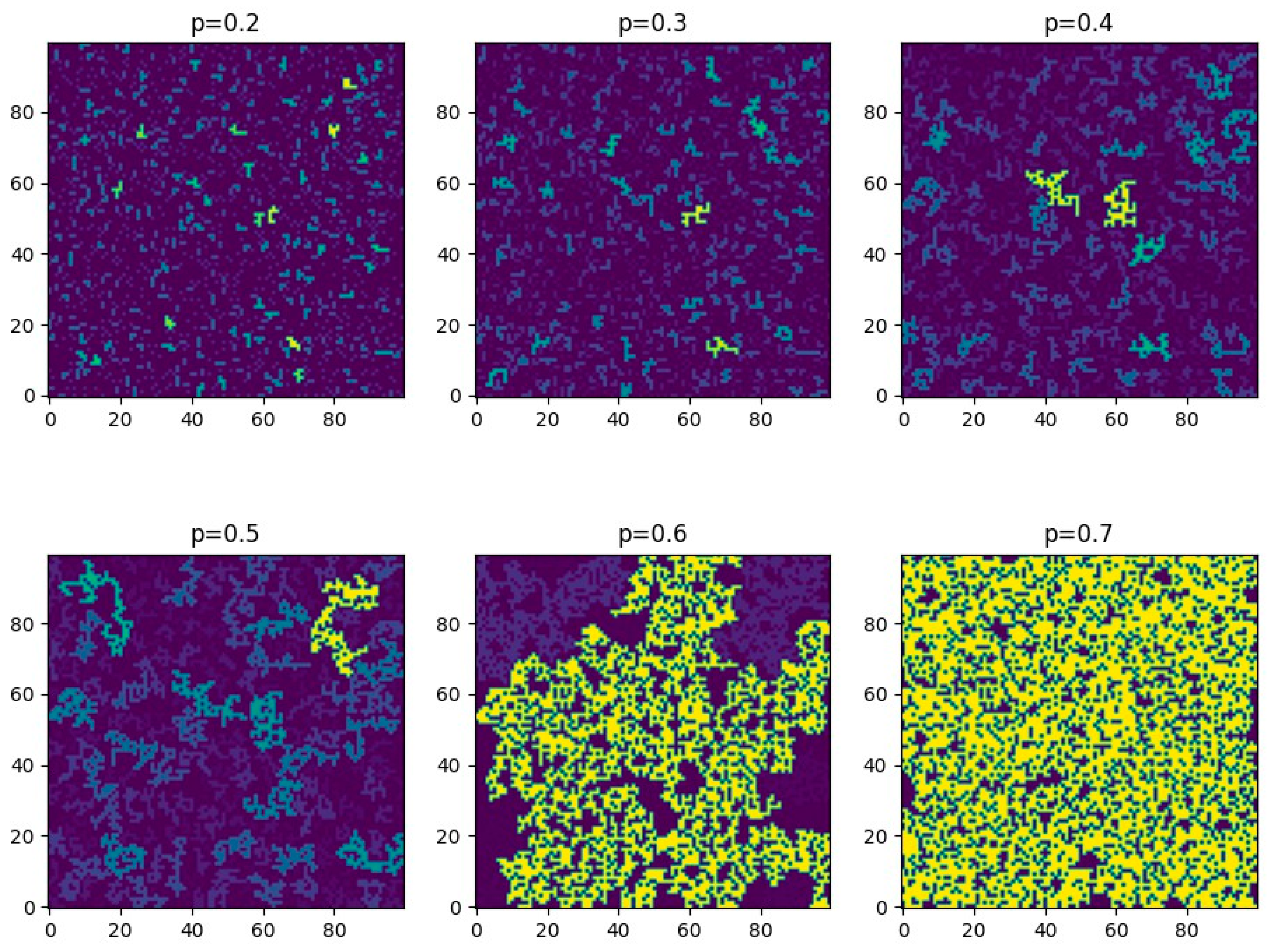
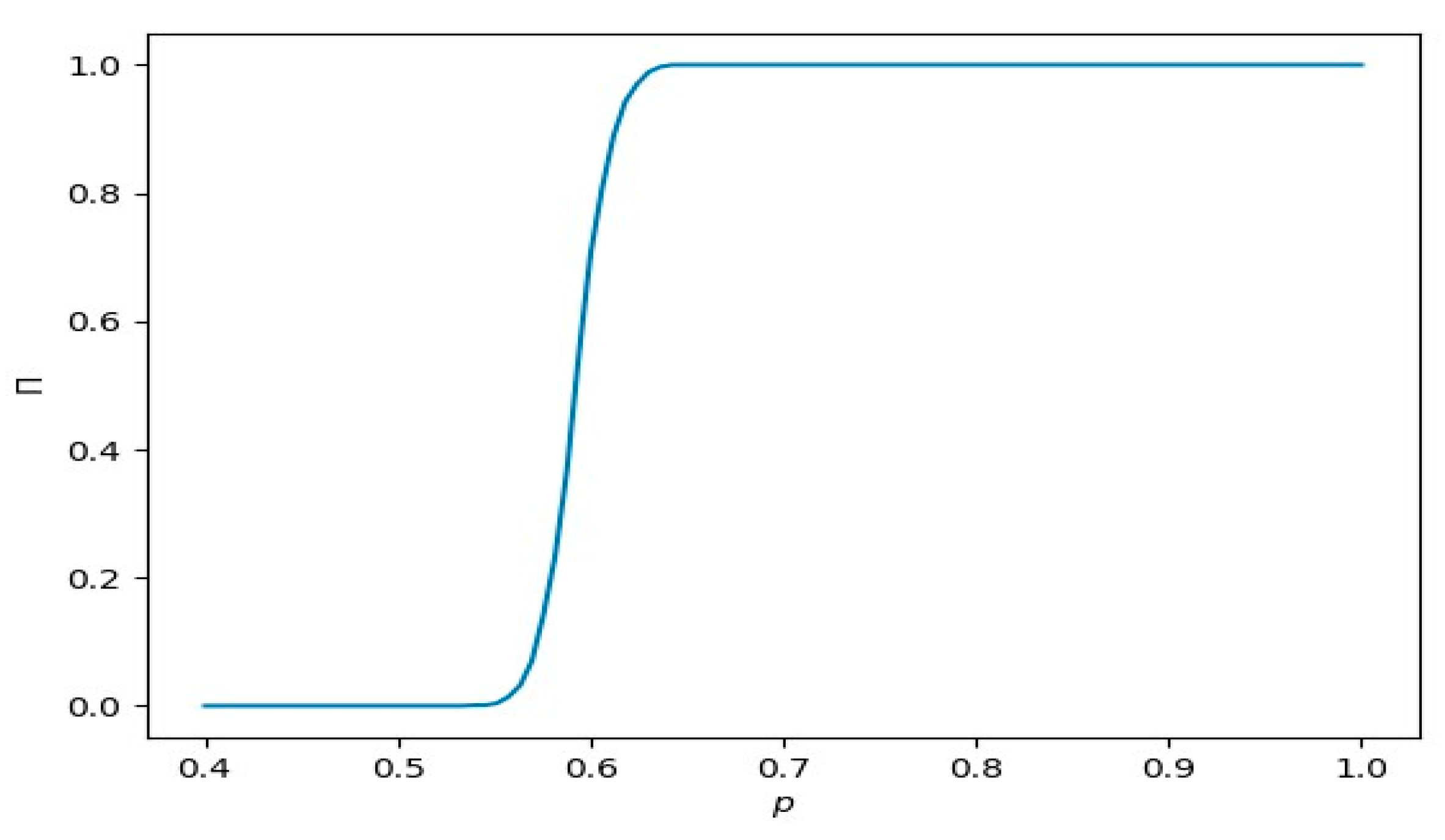


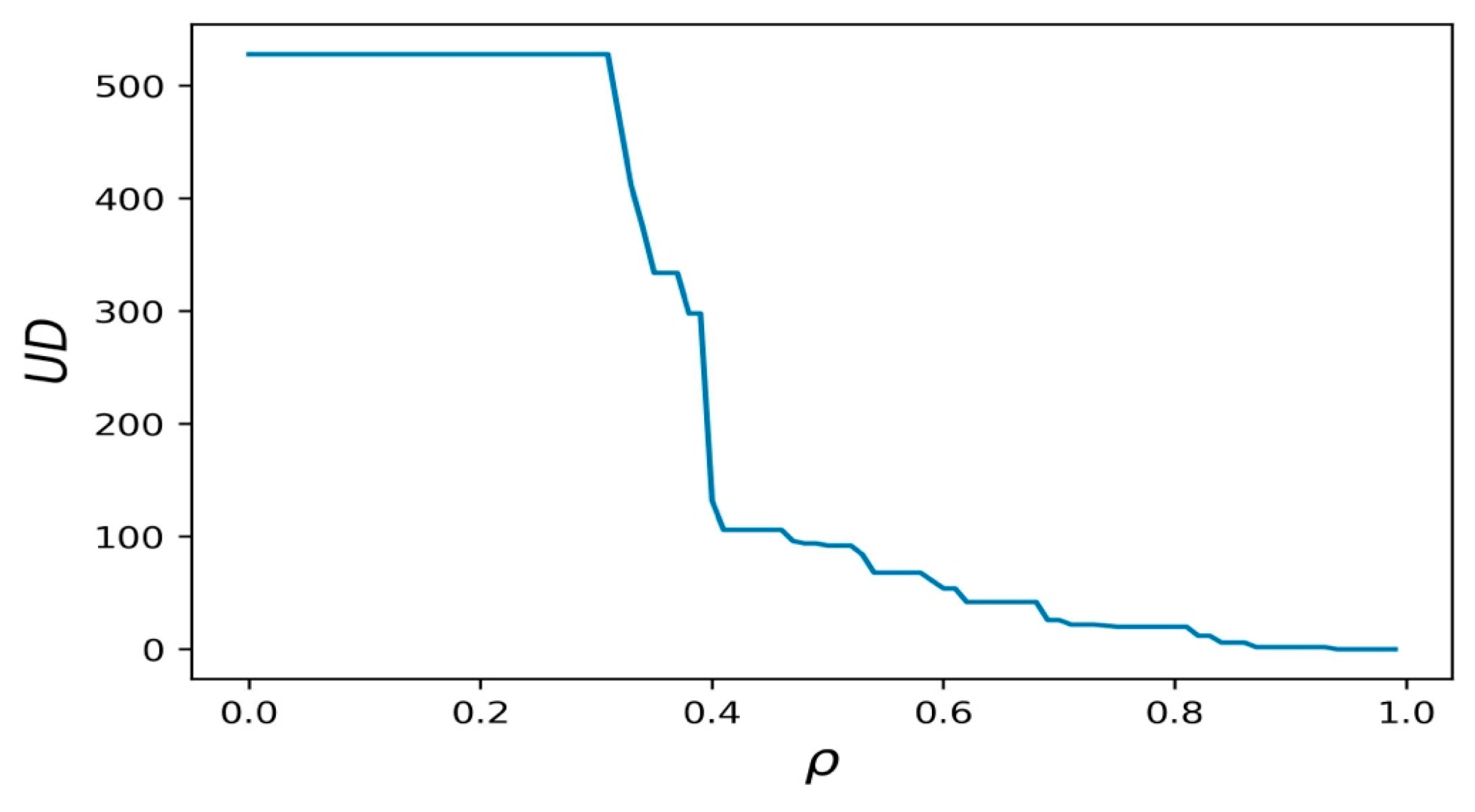

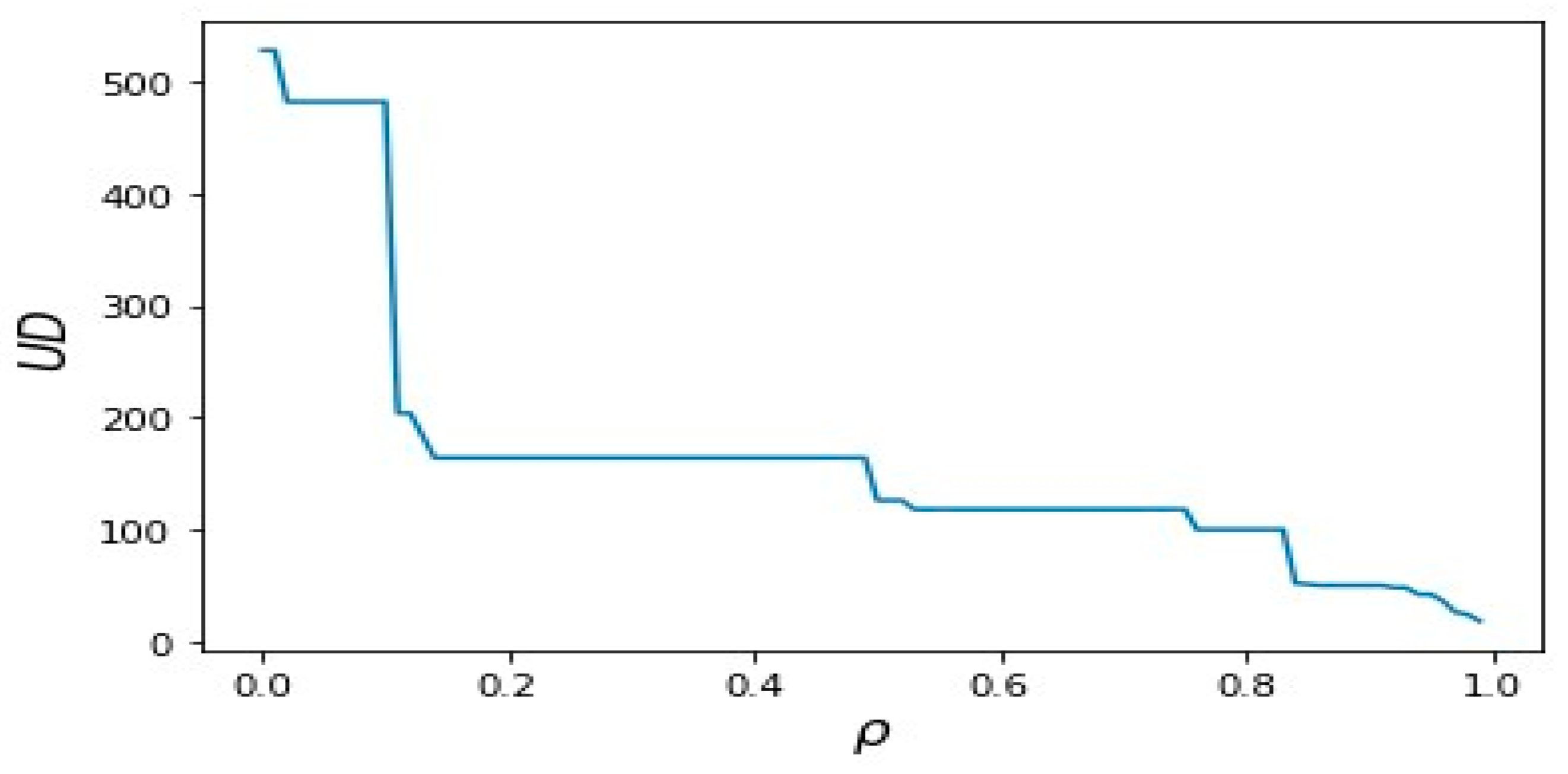
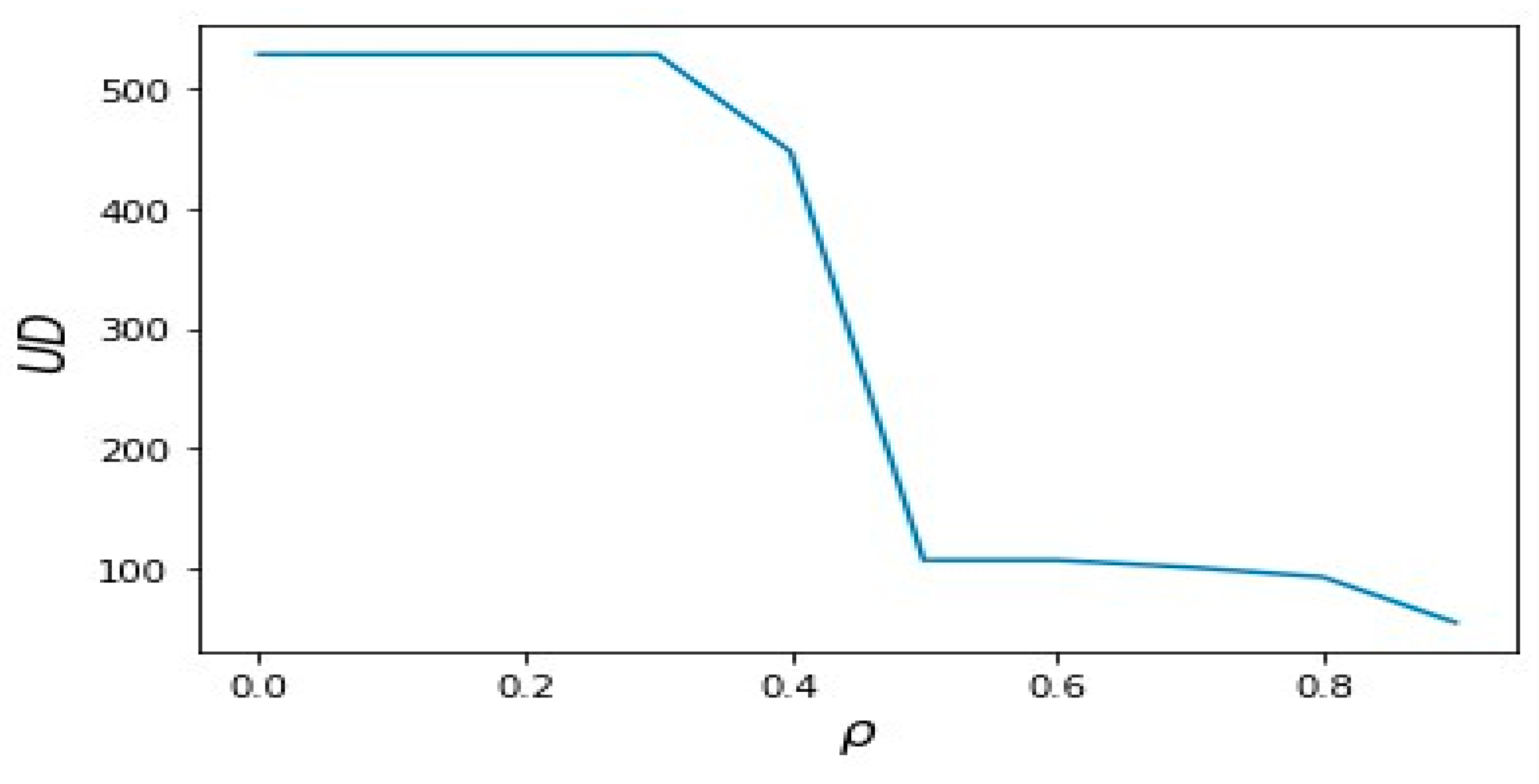

Disclaimer/Publisher’s Note: The statements, opinions and data contained in all publications are solely those of the individual author(s) and contributor(s) and not of MDPI and/or the editor(s). MDPI and/or the editor(s) disclaim responsibility for any injury to people or property resulting from any ideas, methods, instructions or products referred to in the content. |
© 2024 by the authors. Licensee MDPI, Basel, Switzerland. This article is an open access article distributed under the terms and conditions of the Creative Commons Attribution (CC BY) license (https://creativecommons.org/licenses/by/4.0/).
Share and Cite
Chen, J.; Wu, Y. The Propagation of Congestion on Transportation Networks Analyzed by the Percolation Process. Mathematics 2024, 12, 3247. https://doi.org/10.3390/math12203247
Chen J, Wu Y. The Propagation of Congestion on Transportation Networks Analyzed by the Percolation Process. Mathematics. 2024; 12(20):3247. https://doi.org/10.3390/math12203247
Chicago/Turabian StyleChen, Jieming, and Yiwei Wu. 2024. "The Propagation of Congestion on Transportation Networks Analyzed by the Percolation Process" Mathematics 12, no. 20: 3247. https://doi.org/10.3390/math12203247
APA StyleChen, J., & Wu, Y. (2024). The Propagation of Congestion on Transportation Networks Analyzed by the Percolation Process. Mathematics, 12(20), 3247. https://doi.org/10.3390/math12203247







